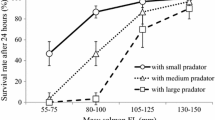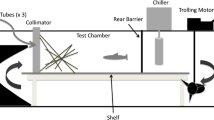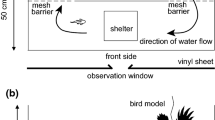Summary
During their first 1–2 years of life, juvenile coho salmon (Oncorhynchus kisutch) are stream-dwelling, and feed upon drifting invertebrates. They move upstream from a holding position to intercept individual prey items; the distance moved (attack distance) is an increasing, but decelerating, function of prey size. Since the fish are presumably more visible to predators during such feeding excursions, prey size and risk are associated variables.
The effect on attack distance of the presentation of a model predator (a photograph of a rainbow trout) was examined in the laboratory. Attack distances are shortened following presentation of a predator; this is particularly true when the prey are large (Fig. 1). The extent of the reduction of attack distance is directly related to predator presentation frequency, although there appears to be a minimum level to which it will decline (Fig. 2). Hungry fish and fish in the presence of a competitor (simulated by a mirror) are less responsive to the predator, suggesting a trade-off of energetic requirements and risk (Fig. 3 and Table 3). The effect of predation risk should be to reduce the relative proportion of large prey in a juvenile coho's diet, and its net rate of energy intake.
Similar content being viewed by others
References
Caraco T, Martindale S, Pulliam HR (1980) Avian flocking in the presence of a predator. Nature 285:400–401
Carl GC, Clemens WA, Lindsey CC (1959) The freshwater fishes of British Columbia, 3rd edn. BC Provincial Museum Handbook no 5, Victoria, BC, 192 pp
Cerri RD, Fraser DF (1983) Predation and risk in foraging minnows: balancing conflicting demands. Am Nat 121:552–561
Dill LM, Ydenberg RC, Fraser AHG (1981) Food abundance and territory size in juvenile coho salmon (Oncorhynchus kisutch). Can J Zool 59:1801–1809
Donnelly WA, Dill DM (1984) Evidence for crypsis in coho salmon parr (Oncorhynchus kisutch): substrate colour preference and achromatic reflectance. J Fish Biol 25:183–195
Dunbrack RL, Dill LM (1983) A model of size dependent surface feeding in a stream dwelling salmonid. Environ Biol Fish 8:203–216
Edwards J (1983) Diet shifts in moose due to predator avoidance. Oecologia (Berl) 60:185–189
Freed LA (1981) Breeding biology of house wrens: new views of avian life history phenomena. PhD dissertation, University of Iowa, Iowa City
Gilliam JF (1982) Habitat use and competitive bottlenecks in size-structured fish populations. PhD dissertation, Michigan State University, East Lansing
Grubb TC Jr, Greenwald L (1982) Sparrows and a brushpile: foraging responses to different combinations of predation risk and energy cost. Anim Behav 30:637–640
Iwasa Y, Suzuki Y, Matsuda H (1984) Theory of oviposition strategy of parasitoids. I. Effect of mortality and limited egg number. Theor Popul Biol (in press)
Krebs JR (1980) Optimal foraging, predation risk and territory defense. Ardea 68:83–90
Lima SL, Valone TJ, Caraco T (1984) Foraging efficiency-predation risk trade-off in the grey squirrel. Anim Behav (in press)
Maiorana VC (1976) Predation, submergent behavior, and tropical diversity. Evol Theory 1:157–177
Martindale S (1982) Nest defense and central place foraging: a model and experiment. Behav Ecol Sociobiol 10:85–89
Mason JC (1976) Response of underyearling coho salmon to supplemental feeding in a natural stream. J Wildl Manage 40:775–788
Milinski M, Heller R (1978) Influence of a predator on the optimal foraging behaviour of sticklebacks (Gasterosteus aculeatus L.). Nature 275:642–644
Mittelbach GG (1981) Foraging efficiency and body size: a study of optimal diet and habitat use by bluegills. Ecology 62:1370–1386
Power ME (1984) Depth distributions of armored catfish: predator-induced resource avoidance? Ecology 65:523–528
Pyke GH, Pulliam HR, Charnov EL (1977) Optimal foraging: a selective review of theory and tests. Q Rev Biol 52:137–154
Sih A (1982) Foraging strategies and the avoidance of predation by an aquatic insect, Notonecta hoffmanni. Ecology 63:786–796
Thompson DBA (1983) Prey assessment by plovers (Charadriidae): net rate of energy intake and vulnerability to kleptoparasites. Anim Behav 31:1226–1236
Werner EE, Gilliam JF, Hall DJ, Mittelbach GG (1983) An experimental test of the effects of predation risk on habitat use in fish. Ecology 64:1540–1548
Author information
Authors and Affiliations
Rights and permissions
About this article
Cite this article
Dill, L.M., Fraser, A.H.G. Risk of predation and the feeding behavior of juvenile coho salmon (Oncorhynchus kisutch). Behav Ecol Sociobiol 16, 65–71 (1984). https://doi.org/10.1007/BF00293105
Received:
Accepted:
Issue Date:
DOI: https://doi.org/10.1007/BF00293105




